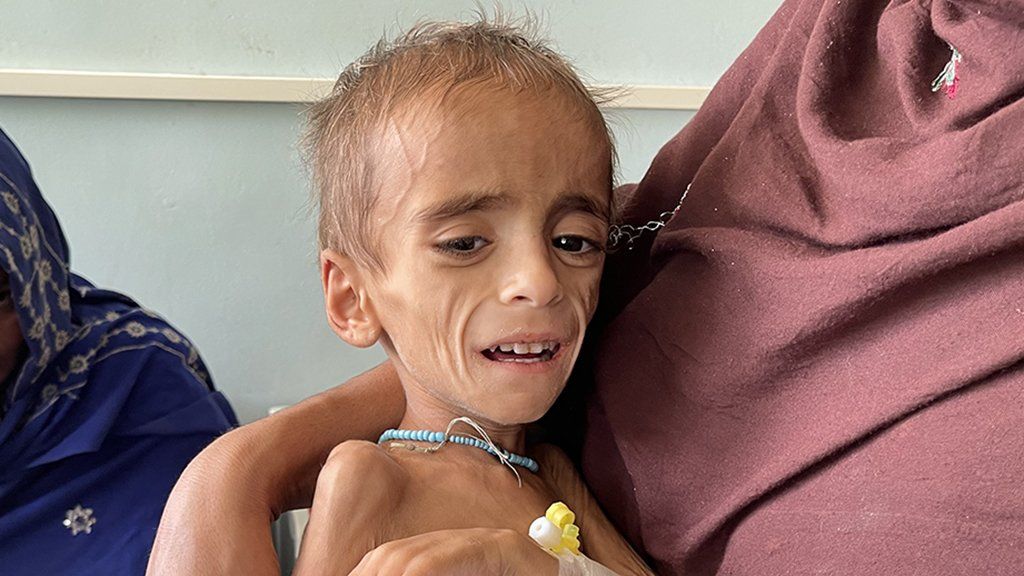She’s nearly 3 but as small as an infant. This is Afghanistan’s hunger crisis

WARNING: SOME OF THE IMAGES AND VIDEO IN THIS STORY ARE DISTURBINGKamila has been malnourished for eight months now, says her grandmother Bilqis, as she attempts to soothe her in a sparse hospital ward filled with other emaciated children in Kandahar, southern Afghanistan. Too weak to cry, the little girl rubs her ears in pain.”Her mother is sick and we are poor people,” Bilqis says. “She tried to breastfeed her but had no milk to give.” Kamila’s family are among millions of Afghans struggling to survive severe food shortages during a harsh winter and economic crash. Rights organizations are pleading for more foreign aid, arguing the most vulnerable groups — women and children — are suffering. In a statement to CNN, the ruling Taliban acknowledged the country’s “economic problems” — but vehemently denied there was a crisis, calling such claims “fake news.””No one will starve cause there is no famine and the cities are full of food,” said Taliban spokesperson Zabihullah Mujahid — contradicting graphic images of starving children.span{color:#C5C5C5;}
]]>
Kamila, a nearly 3-year-old girl suffering from malnutrition, at a hospital in Kandahar, Afghanistan. Credit: CNNEven before the Taliban seized power in Afghanistan in August, poverty and food insecurity were widespread due to back-to-back droughts, economic decline, protracted conflict and the pandemic. But three months after the takeover, the crisis has rapidly worsened. Billions of dollars of foreign development aid has dried up, depriving the country of money that had been propping up the economy, key services and aid workers.As winter sets in, nearly 23 million people — more than half the population — are facing extreme levels of hunger, according to the United Nations. At least a million children under 5 are at risk of dying from starvation. Conditions are so bad that some hospitals, without money for fuel, have resorted to cutting down trees to heat patients’ rooms, and aid groups warn the situation will only get worse if the international community doesn’t act now.Desperate families sell everythingThe unforgiving weather has exacerbated food shortages.The vast majority of Afghans rely on agriculture for their livelihoods, but the country has lost 40% of its harvest this year to the drought, according to the World Food Programme (WFP). As food supplies dwindle, the cost of staples like wheat and bread have skyrocketed.”We only have water and bread — sometimes we have it, but sometimes there’s nothing to eat,” said Musafer, a laborer and shopkeeper who goes by one name.Earlier this month, he took his daughter to Ghor Provincial Hospital in the provincial capital Chagcharan. Razia is almost 3 years old, but her ribs and spine jut out with horrifying clarity as she buries her face in her mother’s lap. This is her third hospital visit in just eight months — and she’s not getting better.”There is no work, no income, no food to bring her,” Musafer said. “Every time I see her I get upset.”span{color:#C5C5C5;}
]]>
Razia, who is almost 3, received treatment for malnutrition at Ghor Provincial Hospital. Credit: CNNRichard Trenchard, the Food and Agricultural Organization Representative in Afghanistan, described the situation as “disastrous” in a November statement. “Every farmer we’ve spoken to has lost almost all of their crops this year, many were forced to sell their livestock, they have accumulated enormous debts and simply have no money,” he said.Before the Taliban’s takeover, poverty had been common in many of the country’s rural areas — but now, middle class and urban residents have also been plunged into despair.Government workers and school principals — many of whom have gone months without pay — are among those queuing up for food rations and medical attention, the WFP warned. Across the country, families are selling their clothing, furniture, livestock — sometimes even entire houses — for food, the agency said in a news release. Martin Griffiths, the UN Emergency Relief Coordinator, said Afghanistan will not get through the winter on emergency aid alone.”The need for liquidity and stabilization of the banking system is now urgent — not only to save the lives of the Afghan people but also to enable humanitarian organizations to respond,” he said in a statement on Sunday.For Afghan families on the ground, there is nothing to do but wait for help to arrive. After 15 days of treatment, Nasrin was released from the hospital, weighing just over 14 pounds (6 kilograms). The family returned home, where there are four other hungry children waiting. “I ask the international community to help every poor person who are suffering from poverty and hunger,” said Rauf, Nasrin’s father. “If they don’t help us, I will lose my kids.”


